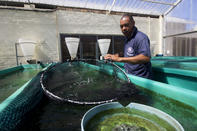In certain freshwater fish farming systems (aquaculture), fish are kept and grown in net cages suspended in a dam or lake while other aquaculture systems use tanks and dams for commercial fish farming.

Frequent inspection and regular maintenance of equipment reduces operational costs and improves production efficiency.
Clean nets improve water flow through nets and provide oxygenation. Keep nets clean of algae growth by lifting one side and allowing it to wind dry. The dried algae can then be brushed off. Inspect the net cages weekly by lifting one side at a time to look for holes and tears that might lead to fish escaping.
Inspecting the Cage Nets
This could be done every week and also during the monthly test sampling and harvesting days. Structural investigation of cages, netting and anchoring should also be done after the emergency movement of cages due to, for example, low oxygen conditions and inclement weather conditions.
Protecting Net Cages
Cages must be protected from predators such as cormorants and otters. Install an anti-predator net on the outside of the cages suspended to a depth of at least 1 m below the bottom of the net cages.Removal of Dead Fish
Fish die due to poor water quality conditions, diseases and wounding by predators. Remove dead fish immediately. Dead fish also lie on the bottom of the net for a few days before surfacing. Dead fish on the bottom should be removed during routine net inspection.
Production sites should be inspected on a daily basis for any dead fish, which should be removed and disposed of in an environmentally friendly manner to prevent the spread of disease.
It can be buried in a deep pit; add a cup full of agricultural lime per medium-sized fish. Lime improves the decomposition of organic matter. Other ways to dispose of dead fish include the burning of carcasses or the use of acid. All fish deaths (single incidents and mass mortalities) should be recorded. Also note the possible causes.
Checking the Platforms
The stability and anchorage of cage net anchor lines should be checked as well as the safety and integrity of the floatation of the cage structure, plus the transport float between the cages and the banks of the dam should be inspected regularly.
Maintain the cleanliness of cage platforms. Platforms should be swept daily to remove old feed, bird droppings and slime from fish. It can become slippery in wet conditions and water safety regulations for staff should be exercised at all times.
Check for any sign of corrosion to cage collars and net cage platforms. Attach old tyres between the cage structure and the transport float to prevent damage to the galvanising of both structures.
Cleaning of Dams and Tanks
In open systems where fish are not kept in net cages, inspections will include the checking of pumps, cleaning of filters and pipes, cleaning out dead fish and checking water levels. Grass should be cut around dams and dams cleaned regularly.
Once a year dams should be drained and dried in the sun. Depending on the season and whether tanks are indoors or outside, they should be cleaned weekly or every two weeks. In summer, when algae growth is more prolific, a weekly clean is advised.
Clean the screens of the pumps, inlets and outlets daily. Regular water analyses are essential to prevent stress to fish as a cause of disease.
By Marinda Louw